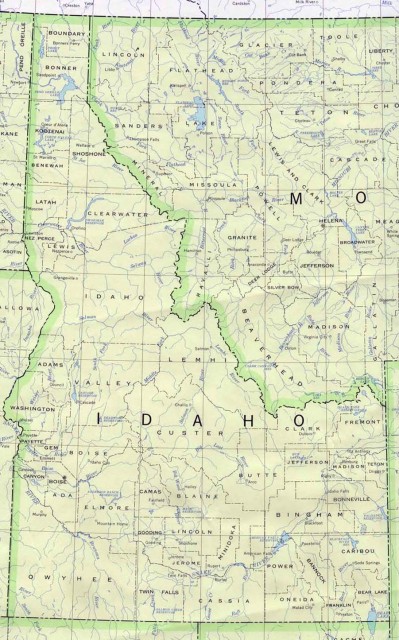The State of Idaho
AT A GLANCE
Name: The meaning of the name Idaho is unknown, although it is believed to be of Native American origin.
Nickname: Gem State
Capital: Boise
Size: 83,574 sq. mi. (217,292 sq km)
Population: 1,654,930 (2015 est)
Statehood: Idaho became the 43rd state on July 3, 1890.
Electoral votes: 4 (2016)
U.S. Representatives: 2 (until 2016)
State tree: western white pine
State flower: syringa
State horse: Appaloosa
Highest point: Borah Peak, 12,662 ft. (3,859 m)

THE PLACE
Idaho is famous for its rugged scenery. The eastern part of the state is known as the Panhandle and is covered by the Rocky Mountains. This area has mineral deposits, lush pine forests, and deep gorges.
Southwest of the mountainous Panhandle region is a flatter area along the Snake River. Part of this fertile plain was formed by lava seeping through cracks in the earth. Farmers grow a variety of crops in this part of the state. The southwestern portion of the state is much drier and more suitable for grazing cattle and sheep.
Idaho's climate is relatively mild. Mountains protect the state from cold Canadian air, while warmer air from the Pacific keeps temperatures relatively stable. Winter in Idaho is snowy, and summer is cool.
Idaho's many natural mineral deposits include silver, phosphate, and molybdenum. The state's powerful rivers, rich soils, and thick forests are its most valuable resources.
Facts and Firsts
- Sun Valley was the nation's first ski resort.
- Hell's Canyon, along the Snake River, is the deepest gorge in North America. On average, it is more than 1 mile (1.6 km) deep.
- More than 3 million gallons of steaming mineral water pour through Lava Hot Springs every day.
- The oldest standing building in the state is the Cataldo mission, built in the mid-1800s by Jesuit priests and members of the Coeur d'Alene tribe.
- The highest fire lookout in the Boise National Forest sits on Trinity Mountain at an elevation of 9,500 feet (2,896 m).
- Idaho has many ghost towns, including Silver City, Yankee Fork, Gold Dredge, and the Sierra Silver Mine.
- The only captive geyser in the world is in Soda Springs. It was discovered while searching for a hot water source for a swimming pool. It is now capped, controlled by a timer, and erupts every hour on the hour.
THE PAST
Remains of Native American civilizations more than 10,000 years old have been found in Idaho. The Nez Perce and Shoshone tribes, among many others, made their home in Idaho at one time. In 1805, Meriwether Lewis and William Clark explored the region during their expedition to the western United States. Soon after their visit, settlers began to trickle into the state. In 1860, E.D. Pierce's discovery of gold in Orofino Creek set off a gold rush that brought thousands of settlers to the region. Railroads built in the 1870s helped increase Idaho's population, and mining became an important industry.
Agriculture began to expand at the beginning of the 20th century, when irrigation made more of Idaho's land suitable for farming. Idaho's farmers helped supply food for the country during the shortages of World War I. During World War II, factories were built to process much of the food grown in the state, and Idaho's food-processing industry grew. Increased tourism and manufacturing also helped build Idaho's economy.
THE PRESENT
Idaho has many important natural resources, including timber, water, and minerals, but today tourism and manufacturing account for much of the state's revenue.
Idaho's Rocky Mountains ski resorts, such as Sun Valley, and other unspoiled areas nurture one of Idaho's newest businesses—the tourist trade. Idaho's lakes and rivers are popular fishing areas for visitors.
Electrical equipment and food processing are Idaho's most valuable types of manufacturing. The food-processing industry prepares many of Idaho's crops, such as potatoes, sugar beets, and wheat, for sale throughout the United States. The electrical equipment industry makes many of the parts needed in Idaho's computer industry. While manufacturing is important, the raising of sheep and cattle is essential to the economy in Idaho's drier regions.
The manufacturing industry is transforming Idaho into an urban state, but cattle and dairy goods are the leading agricultural products in rural areas. Mining, once a major source of income, is still important and produces phosphates, gold, silver, molybdenum, antimony, lead, zinc, and other minerals.
Born in Idaho
- Gutzon Borglum, Mt. Rushmore sculptor
- Carol R. Brink, author
- Frank Church, U.S. senator
- Harmon Killebrew, baseball player
- Ezra Pound, poet
- Sacagawea, Shoshonean guide
- Picabo Street, skier
- Lana Turner, actress